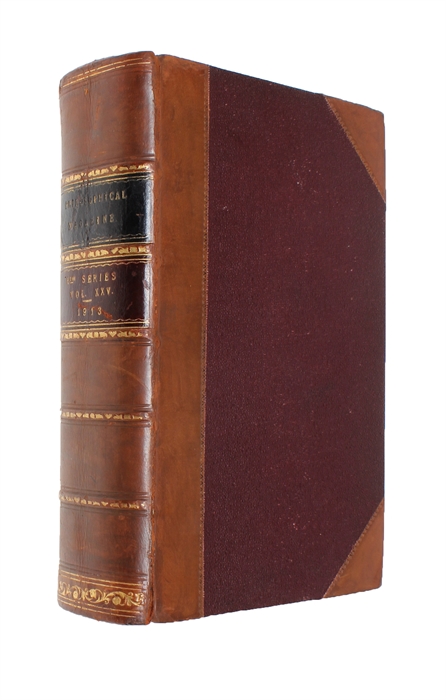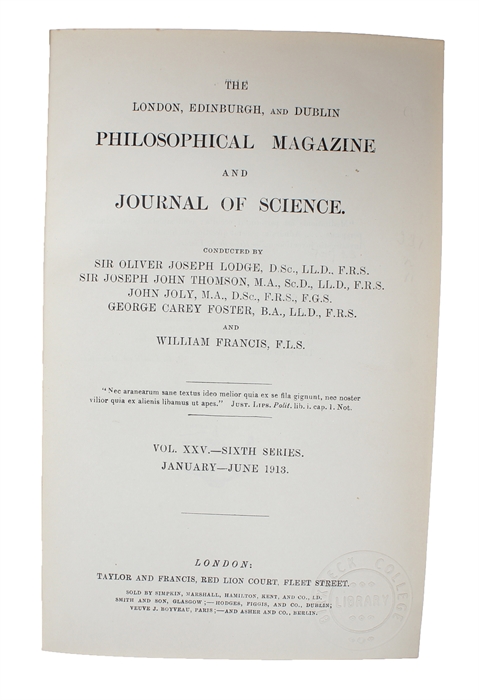THE FOUNDATION OF BOHR'S ATOMIC THEORY
BOHR, NIELS.
On the Theory of Decrease of Velocity of Moving Electrified Particles on passing through Matter
London, Taylor & Francis, 1913. 8vo. Bound in one nice contemporary half calf binding with gilt leather title-label to spine. Published in "The London, Edinburgh, and Dublin Philosophical Magazine and Journal of Science", Vol. 25. No. 145-150 offered. Small repair to spine and blind stamped to lower part of title page. The Bohr papers: pp. 10-31. [Entire volume: VIII, 876 pp.+ 10 plates].
Bohr's seminal first work on nuclear physics, being the work that lays the foundation for his atomic theory (published before his "On the Constitution of Atoms and Molecules"), in which he is able to conclude "that a hydrogen atom contains only 1 electron outside the positively charged nucleus, and that a helium atom only contains 2 electrons outside the nucleus ."
"Bohr's 1913 paper on alpha-particles [i.e. the present], which he had begun in Manchester, and which had led him to the question of atomic structure, marks the transition to his great work, also of 1913, on that same problem. While still in Manchester, he had already begun an early sketch of those entirely new ideas." (Pais, p. 128). The present work must be considered one of the most important to the birth of modern atomic theory.
After finishing his studies in Copenhagen, Bohr went to Cambridge in order to pursue his studies on electron theory under the guidance of J.J. Thompson. Thompson, who was beginning to lose interest in the subject by now, did, however, not recognize the genious of the young Bohr, and as soon as he could, Bohr went to Manchester, where Ernest Rutherford had established a laboratory. "There, from March to July 1912, working with utmost concentration, he [i.e. Bohr] laid the foundation for his greatest achievements in physics, the theory of the atomic constitution." (DSB). Bohr's survey of the implications of Rutherford's atomic model had led him to attack the much harder problem which lay at the core of it, namely determining the exact nature of the relation between the atomic number and the number of electrons in the atom. "Bohr obtained a much deeper insight into the problem by a brilliant piece of work, which he - working, as he said, "day and night" - completed with astonishing speed" (DSB), that paper being the present "On the Theory of the Decrease of Velocity of Moving electrified Particles on passing through Matter", which thus constitutes his very first publication on the subject, published immediately after this dense period of 1912, in the Philosophical Magazine of January 1913.
"The problem was one of immediate interest for Rutherford's laboratory: in their passage through a material medium, alpha particles continually lose energy by ionizing the atoms they encounter, at a rate depending on their velocity. Their energy loss limits the depth to which the particles can penetrate into the medium, and the relation between this depth, or range, and the velocity offers a way of determining this velocity. What Bohr did was to analyze the ionizing process on the basis of the Rutherford model of the atom and thus express the rate of energy loss in terms of the velocity by a much more accurate formula than had so far been achieved-a formula, in fact, to which modern quantum mechanics adds only nonessential refinements" (DSB). In the present work, Bohr was thus able to conclude: "In this paper the theory of the decrease of velocity of moving electrified particles in passing through matter is given in a form, such that the rate of the decrease in the velocity depends on the frequency of vibration of the electrons in the atoms of the absorbing material." as well as the seminal words that have been formative for the birth of the modern atomic theory: "Adopting Prof. Rutherford's theory of the constitution of atoms, it seems that it can be concluded with great certainty, from the absorption of alpha-rays, that a hydrogen atom contains only 1 electron outside the positively charged nucleus, and that a helium atom only contains 2 electrons outside the nucleus ". Bohr continues: "These questions and some further information about the constitution of atoms which may be got from experiments on the absorption of alpha-rays, will be discussed in more detail in a later paper." (pp. 30-31 of the original paper) - the last sentence referring directly to his three part "On the Constitution of Atoms and Molecules", in which he went on to present his postulates of the orbital structure of the electrons and their quantized radiation.
Rosenfeld, Bohr Bibliography No. 5. Rosenfeld, Dictionary of Scientific Biography II, pp. 240-41. Pais, Niels Bohr's Times, pp. 117-31.
Order-nr.: 51729


